The Charles Bridge is famous for the many statues of saints that embellish the bridge along its length. For centuries, this bridge was the only link between Lesser Town on the left bank of the Vltava river and Old Town on the opposite side.

From the bridge you have amazing views over Prague’s many medieval towers, churches and palaces. The view towards Lesser Town, dominated by the Prague castle complex, is particularly picturesque.
History
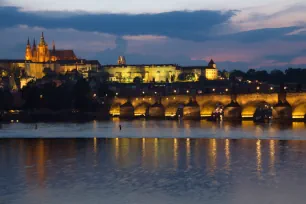
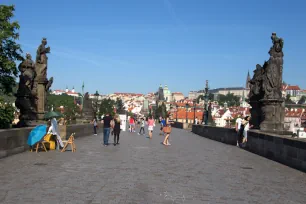
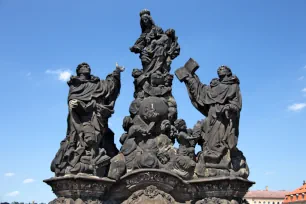
Due to its prominent position, the Charles Bridge has played an important part in Prague’s history. In 1648, at the end of the Thirty Years’ War, the invading Swedes were halted on this bridge and in 1744 the Prussians were defeated here. Today, the bridge is often overrun with tourists and souvenir vendors, but it is nonetheless a must-see for any visitor to Prague.
Judith Bridge
As early as in 1158, during the reign of King Vladislav II, a stone bridge was built near the site of the current Charles Bridge. It replaced an older wooden structure and was one of the first stone bridges in Europe built after the fall of the Roman Empire. The bridge, completed in 1172, was named Judith Bridge (Juditin most), for Judith of Thuringia, spouse of Vladislav II, who actively backed the construction of the bridge. The Judith Bridge was swept away when the Vltava river flooded in 1342.
Prague Bridge
In 1357 King Charles IV ordered the construction of a new bridge. The supervisor of the project was Peter Parler, who at this time had also started working on the St. Vitus Cathedral. Parler built a 502-meter-long (about 1,600 ft.) bridge just north of the former Judith Bridge. Resting on sixteen arches, it was wide enough for four carriages to cross at the same time. Construction of the bridge was completed in 1402. For more than three centuries (until 1742) the bridge would be the only permanent link between both riversides.
At the time the bridge was known as the Prague or Stone Bridge. It wasn’t until 1870 before it was renamed Charles Bridge after King Charles IV.
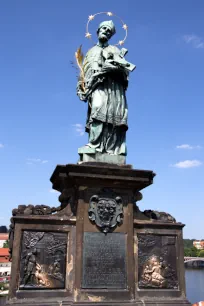


Adding Statues
Originally, the Charles Bridge was devoid of any ornamentation, except for a wooden cross that was placed at its center. In the seventeenth century, the cross was replaced by a bronze crucifix. The first statue – of St. John of Nepomuk – was added in 1683.
The statue became popular and as a result more than twenty additional statues were added in the early eighteenth century. Even more statues were added over time; the most recent one was created in 1938. Today in total thirty sculptures adorn the bridge.
The Bridge Today
It’s hard to imagine now, but the Charles Bridge was long a major thoroughfare, and there even used to be a tram on the bridge. In 1950 the bridge was pedestrianized, and today it is almost always crowded with tourists and street vendors.
The Statues
The Charles Bridge is famous mostly for the series of Baroque statues that adorn the bridge’s balustrade. Many of the original statues have been replaced by copies, since the mostly sandstone sculptures were badly affected by the elements or were damaged and even swept away during one of the Vltava river’s frequent floods. The originals are now displayed in the Lapidarium, a museum at the Prague Exhibition Grounds.
Not all statues are of great quality, but some are excellent works of art, in particular those created by the Bohemian artists Ferdinand Brokoff and Matthias Braun. Below, a small selection of some of the most notable statues.
The bronze statue of St. John of Nepomuk was created in 1683 by Matthias Rauchmüller and Jan Brokoff. It was the first statue on the bridge, and it’s easy to see why this site was chosen: in 1393 then-archbishop Nepomuk was tortured to death and his body was thrown off the Charles Bridge. Reliefs below the statue depict this event. Touching the relief is supposed to bring luck.
One of the most acclaimed works on the bridge is the sculpture group of St. Lutgarde, created in 1710 by Matthias Braun. It shows the blind Flemish nun Lutgarde, who sees the crucified Jesus in a vision.
Close to the Lesser Town Bridge Towers are two magnificent sculptures created by Ferdinand Brokoff in 1714. One shows three saints: St. John of Mata, St. Felix of Valois and St. Ivan. They founded the Trinitarian Order. Opposite stands the statue of St. Vitus. His foot is being licked by a lion who was supposed to devour him in the arena.
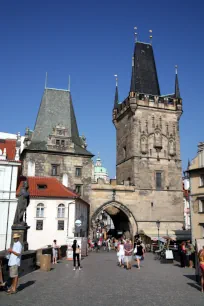
Bridge Towers
Access to the Charles Bridge was protected by bridge towers, built at either end of the bridge. The tower on the side of the Old Town, known as Old Town Bridge Tower, was built by Peter Parler between 1370 and 1391.
On the Lesser Town end of the Charles Bridge are two bridge towers. The smaller one, the Judith Tower, was built in 1188 to guard the entrance to the Judith Bridge. The adjoining, taller tower was erected in 1464 on the orders of King George of Poděbrady, who wanted a counterpart to the Old Town Bridge Tower.
- Next: Prague Castle
- More Sights & Attractions in Prague
